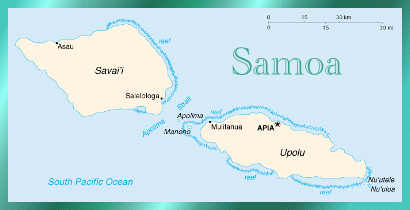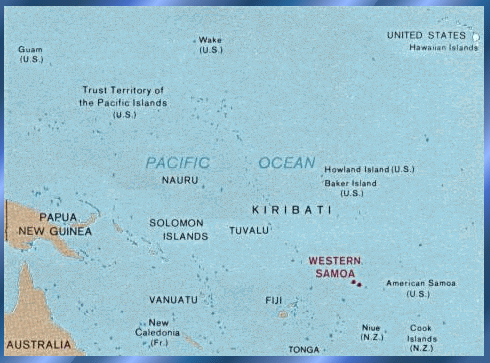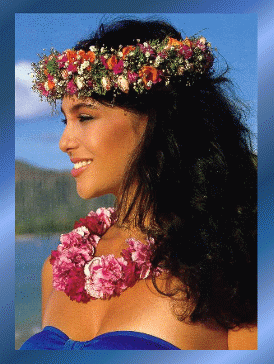 |
|
|
 |
|||||
|
Conventional long
form: Former: Western Samoa |
Conventional short
form: Data code: WS |
|
|||||||
GeographySamoa lies 2,575 kilometers (1,600 mi.) northeast of Auckland, New Zealand. The main islands are formed from ranges of extinct volcanoes, rising to 1,857 meters (6,094 ft.) on Savai'i and 1,100 meters (3,608 ft.) on Upolu. Volcanic activity last occurred in 1911. The climate is tropical, with wet and dry seasons. The mean daily temperature is 27 degrees C (80 degrees F). Average annual rainfall is about 287 centimeters (113 in.), of which 190 centimeters (75 in.) falls from October to March. Although Samoa lies outside the normal track of typhoons, severe storms occasionally strike. |
 |
|||||
PeopleNationality: Noun
and adjective--Samoan(s) More than 2,000 years ago, waves of Polynesians migrated from Southeast Asia to the Samoan Islands. Samoans are the second largest Polynesian group, after the Maoris of New Zealand, and speak a Polynesian dialect. |
 |
|||||
|
Samoans have tended to retain their traditional ways despite exposure to European influence for more than 150 years. Most Samoans live within the traditional social system based on the aiga, or extended family group, headed by a matai, or chief. The title of matai is conferred upon any eligible member of the group, including women, with the common consent of the aiga. In addition to representing the aiga in village and district fono (councils), the matai is responsible for the general welfare of the aiga and directs the use of family lands and other assets. Apart from Apia, the capital and commercial center, Samoa has no major towns. Most people live in some 400 coastal villages, with populations ranging from 100 to more than 2,000. About 3,200 foreign nationals live in Samoa. |
History
The islands were discovered in 1722 by a Dutch explorer Jacob Roggeveen (1659-1729). In 1768, French navigator, Louis de Bougainville, sighted the islands of Samoa calling them the "Navigator Islands" because he encountered many Samoans sailing small canoes far from the sight of the land and assumed they must be good navigators. Around 1800, ships began to call at Samoa for supplies, but contacts did not become intensive until the arrival of English missionaries on Savai'i under John Williams in 1830. Once the Samoans accepted the missionaries, whaling and trading ships began making regular stops in the islands. The greatest impact of change on the culture and society of Samoa was the arrival of the western missionaries. The strong influence of the missionaries and their teachings have made the Samoan people devoutly religious to the present day, with much time and resources devoted to church activities. After the arrival of the missionaries and European traders, vast plantations producing copra and cotton were developed for export, and Apia soon became a major commercial center in the South Pacific. Between 1847 and 1861, Great Britain, the United States, and Germany established consular representation at Apia. Two royal families ruled different parts of Samoa during the mid 1800's, and they fought among themselves over who would be king. By the late 1800's, internal strife among the Samoan royal families, and power struggles between the then present opposing colonial powers, led to a period of instability; and reached a climax in 1889, when the signing of the Final Act of the Berlin Conference on Samoan Affairs brought Samoan independence and neutrality. Malietoa Laupepa was recognized as king. After the death of King Laupepa in 1898, a native civil war broke out in 1899. The U.S. and Great Britain formed an alliance against Germany, and Apia, the site of the German station, was shelled by British and U.S. ships. Agreement, however, was reached in the same year. By the treaty then concluded, Germany received the islands west of longitude 171 degrees West (Western Samoa), United States' sovereignty was recognized over the islands east of the meridian. The chiefs of Tutuila and Aunuu ceded these islands to the United States in 1900, and the Manua group was ceded in 1904. Swains Island was annexed by the U.S. in 1925 and added to American Samoa. In 1900, Great Britain received the Solomon Islands and Tonga as compensation. In 1914, following the outbreak of war in Europe, New Zealand's armed forces occupied Western Samoa. In 1919, New Zealand was granted a League of Nations mandate over the territory. In December 1946, Western Samoa was placed under a UN trusteeship with New Zealand as administering authority. In November 1961, the UN General Assembly voted unanimously to end the trusteeship agreement, and the New Zealand Parliament passed the Independent State of Western Samoa Act, formally ending New Zealand's powers over the country on January 1, 1962.
|
Government
The 1960 constitution (which formally came into force with independence on January 1, 1962) is based on the British pattern of parliamentary democracy, modified to take Samoan customs into account. Executive
branch: |
Foreign RelationsThe Government of Samoa has especially close relations with its Pacific island neighbors and New Zealand. A treaty of friendship signed by the Governments of Samoa and New Zealand in August 1962 confirms their special relationship and provides a formal basis for the assistance that New Zealand extends to Samoa. Samoa also has close ties with American Samoa. There are frequent informal contacts between members of extended families, and a considerable number of Samoans are employed in Pago Pago's tuna canneries. Interest in improved economic links between the two Samoas is growing. |
|
MilitaryMilitary branches:
No regular armed services; Samoa Police Force |
EconomyGDP (1995): $164
million Samoa remains predominantly agricultural, and village communities maintain an economy base on farming and fishing. Much of the cultivated land is devoted to subsistence crops such as yams, bananas, breadfruit and pawpaws. More than half of the land is too rugged for agricultural use. Pigs and poultry are the principal livestock. There is little diversification in agricultural exports, with coconut products accounting for over 70 percent of total exports production. The islands have few resources and no deposits of commercially valuable minerals. In 1991, the Japanese company Yazaki set up an auto wiring component assembly plant in Apia which now employs 2700 Samoans. Other than this plant, however, no other large-scale manufacturing concern has established in Samoa. On a smaller scale, there are two regional soft drink and beer bottling plants. The first McDonald's Restaurant in this South Pacific region opened in Apia in 1996. Import payments have risen steadily in response to growing public demand for consumer products. Due to limited export production, the 1995 import to export dollar ration was over 10 to 1. Large-scale developmental aid is received from New Zealand, Australia, Japan, PRC and the EU. The internal transportation system depends largely on roads and island-to-island ferries. Daily intra-island ferry service is available, as well as once-weekly ferry service to American Samoa. The principal port is located at Apia Harbor. Savaii and Upolu island each has a small airport which services Twin Otter flights between the two islands and to American Samoa. Faleolo International Airport, located on Upolu, receives international flights from the U.S. (Hawaii), Australia, New Zealand, Fiji and Tonga. In 1995, the Samoan Government designated tourism as its top economic objective. Tourism is an expanding sector; more than 70,000 tourists visited the islands in 1996. |
TravelClimate and clothing: Climate is mild and equable. Temperature varies between 16 degrees C (61 degrees F) and 34 degrees C (93 degrees F) with a mean temperature of 26 degrees C (80 degrees F). March is the hottest month July and August the coolest but humidity is high at all times. Tropical lightweight clothing is advisable all year. Informal dress may be worn on all occasions. Entry requirements: No visa required for visits up to 30 days, an onward ticket must be presented. For longer visits, application should be made for an appropriate visa at the nearest Samoa mission or consulate. Health: Samoa is free from malaria. Visitors should not drink tapwater. A national hospital is in Apia, and there are district hospitals around the islands of Upolu and Savai'i. Private medical practitioners are available in Apia. Telecommunications: Domestic and international telephone, telex, and telegraph services are available. Samoa is six standard time zones behind eastern standard time. Transportation: Regular air service is available between Samoa and the U.S. (Hawaii and American Samoa), Australia, New Zealand, Fiji and Tonga. Intra-island ferry service is available, as well as ferry service to American Samoa. Taxis, buses, and rental cars are also available. All tourist facilities can be reached by car or within walking distance of access roads.
 Information from The World Factbook 1999 U.S. Department of State, Bureau of East Asian and Pacific Affairs |
Contact Info | Service Agreement | Links |